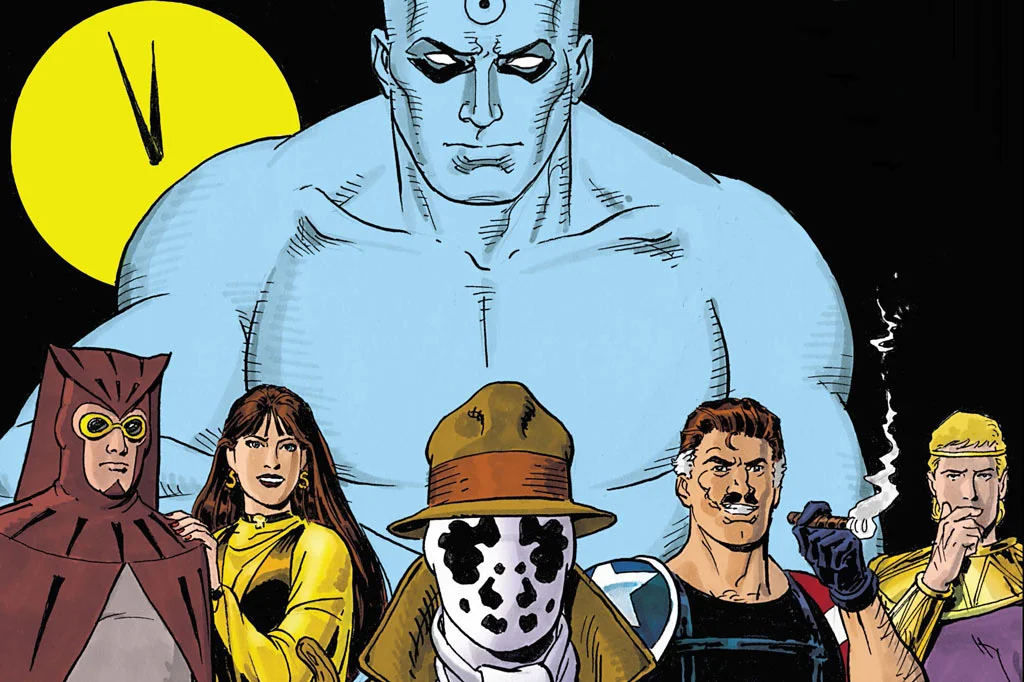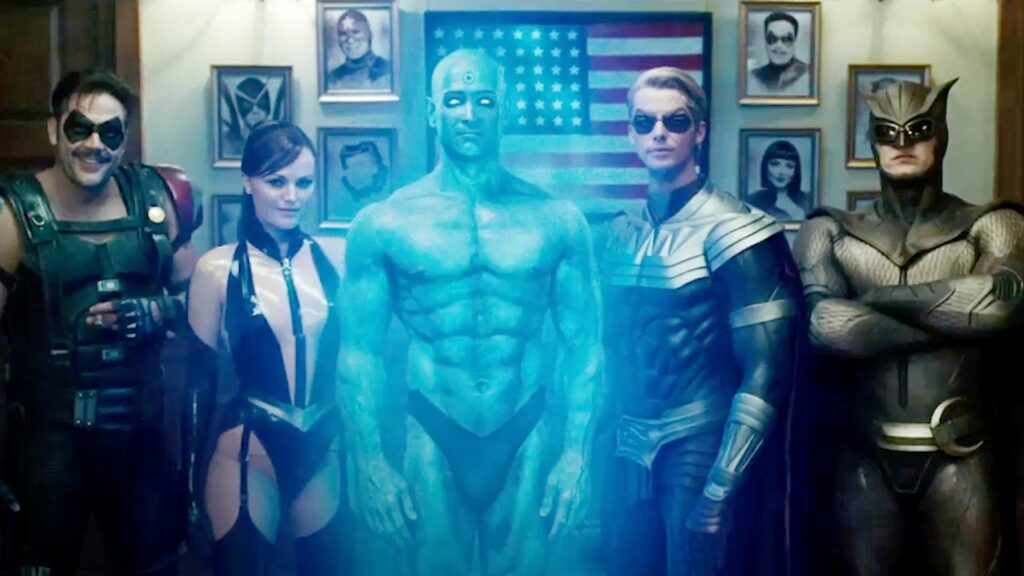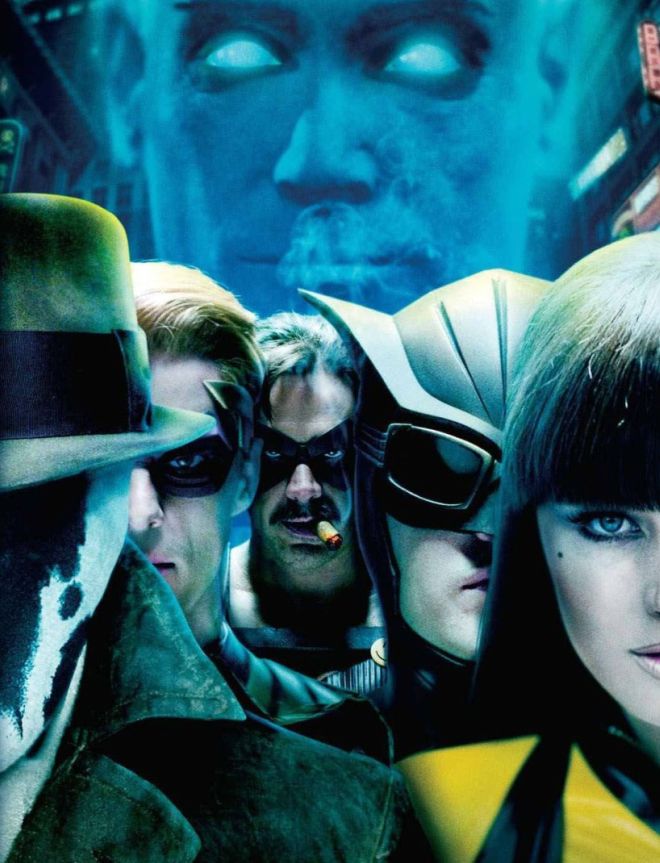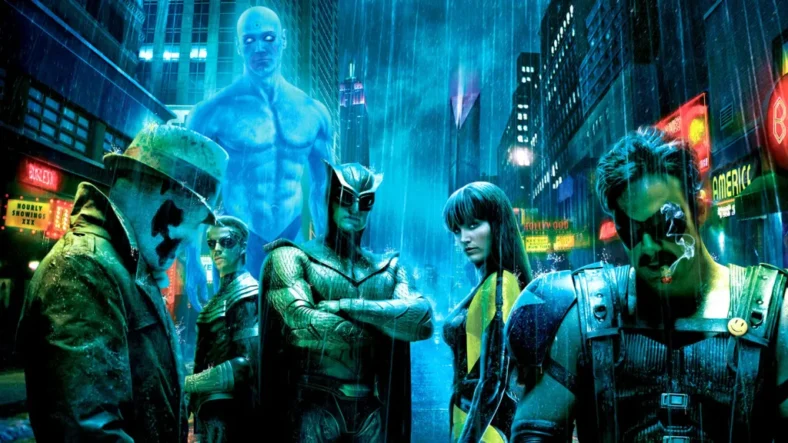The inception of Watchmen as a graphic novel marked a turning point in the comic book landscape. Authored by Alan Moore and artist Dave Gibbons, this narrative experiment dared to challenge the conventions of superhero storytelling. Moore’s intricate narrative, paired with Gibbons’ evocative artwork, birthed a work that transcended the genre, delving into the complexities of morality and human nature. As we embark on the exploration of Watchmen’s evolution, it’s crucial to understand the roots that planted the seed for a narrative that would eventually traverse from static panels to the dynamic realm of cinema.
The Graphic Novel Genesis

Alan Moore’s genius lay not only in crafting a story but in redefining how stories could be told in graphic form. Watchmen, through its intricate narrative structure and morally ambiguous characters, became a literary milestone. The graphic novel not only told a tale of superheroes but also questioned the very nature of heroism and the consequences of absolute power. Dave Gibbons’ art was a visual symphony, enhancing the narrative with subtle details and nuanced expressions. Each panel was a deliberate stroke, contributing to the overall complexity that distinguished Watchmen from its contemporaries. In the midst of this artistic marvel, the convention backdrop seamlessly transformed mundane settings into integral elements of the narrative, adding another layer to the immersive experience.
Beyond the narrative, Watchmen incorporated textual elements such as excerpts from in-universe documents, enhancing the immersive experience. This narrative technique, often absent in traditional comics, added layers of depth, making Watchmen a unique reading experience. The graphic novel’s influence extended beyond the comic book community, permeating the literary world and inspiring subsequent generations of writers and artists to experiment with form and content.
Transition to the Cinematic Realm
Zack Snyder’s directorial vision faced the challenge of translating the graphic novel’s intricacies into the cinematic language. The transition demanded not only a visual fidelity to the source material but a careful balance between homage and reinterpretation. Snyder’s cinematic Watchmen became a canvas where inked panels metamorphosed into moving images. The iconic images from the graphic novel were meticulously recreated, and the film’s visual style paid homage to Gibbons’ artwork, capturing the essence of the original while harnessing the dynamism of cinema.
The cinematic adaptation also allowed for exploration beyond the confines of the graphic novel. Visual effects and cinematography facilitated the portrayal of superhuman abilities and larger-than-life set pieces, elevating Watchmen into a cinematic spectacle. The film’s soundtrack, featuring carefully selected songs that echoed the graphic novel’s thematic depth, further underscored the synergy between visual and auditory storytelling. Despite the challenges inherent in adapting such a revered work, Snyder’s Watchmen managed to carve its place in the cinematic landscape. Additionally, the success of the film caught the attention of the web development company in Chicago, sparking interest in creating an interactive online platform to engage fans and extend the Watchmen experience.
Challenges and Controversies
Adapting Watchmen from page to screen was not without its tribulations. The challenge lay not only in condensing the narrative but in capturing the moral intricacies that defined the graphic novel. The film faced criticism for its deviations from the source material, with purists scrutinizing creative liberties taken in certain scenes. However, these controversies also sparked dialogues about the nature of adaptation and the inherent subjectivity of interpreting a beloved work.
The challenge of condensing a complex narrative into a finite runtime necessitated sacrifices and alterations. Some plotlines were streamlined, and character motivations were distilled for cinematic clarity. While these decisions invited controversy, they also prompted discussions about the inherent differences between static and moving narratives. Watchmen’s journey from graphic novel to film became a case study in the challenges of adaptation, provoking contemplation on the delicate balance between fidelity and innovation. In exploring new avenues, filmmakers considered incorporating the essence of apple extract as a metaphor for the creative challenges faced during adaptation.
The Visual Aesthetics: Crafting a Cinematic Palette
In the transition from graphic novel to the cinematic realm, one of the most captivating aspects of Watchmen was its meticulous attention to visual aesthetics. Zack Snyder, known for his distinctive visual style, undertook the challenge of not just adapting the narrative but translating the graphic novel’s iconic visual elements to the screen. The film’s use of color, a direct homage to Dave Gibbons’ original palette, became a character in itself, influencing the tone and emotional resonance of each scene. Amidst the intricate visual tapestry, the characters were not just adorned in costumes; they were draped in luxury dresses, adding an extra layer of opulence to the film’s already rich visual experience.
The visual aesthetics of Watchmen extended beyond mere replication, becoming a language of its own. Scenes were crafted with a painter’s precision, framing shots that mirrored the iconic panels of the graphic novel. The juxtaposition of vibrant hues against the backdrop of a gritty, alternate reality added layers of meaning to the narrative. It wasn’t just about adapting the story but ensuring that the essence of the graphic novel’s visual identity was encapsulated in every frame. For those seeking a unique and revitalizing experience, consider exploring the world of cinematic creativity while receiving Mobile IV therapy in New Jersey.
Exploring the nuances of this cinematic palette allows us to delve into the intricacies of adaptation beyond narrative fidelity. It’s a testament to the idea that a graphic novel’s visual language can be successfully translated into the cinematic medium, with each color choice and framing decision serving as a bridge between the two storytelling forms.
Character Dynamics on Screen: Bringing Watchmen to Life
As characters leaped from the static pages of the graphic novel to the dynamic screen, the challenge lay not only in physical representation but in capturing the essence of each character’s complexity. Amidst the intricate portrayal of these characters, the actors seamlessly embraced their roles with the help of cutting-edge technology and innovative tools, such as the incorporation of an advanced and user-friendly ergonomic keyboard that facilitated a more immersive and fluid performance. Actors inhabited roles that were not just heroes or antiheroes but nuanced individuals grappling with morality and power. The cinematic adaptation of Watchmen became a playground for the exploration of character dynamics, where the interactions between these complex figures shaped the emotional core of the film.
The transition from panel to screen demanded more than faithful casting; it required a deep understanding of the character’s motivations and inner conflicts. The actors, under Snyder’s direction, brought these characters to life with performances that added new dimensions to the familiar faces from the graphic novel. From Rorschach’s uncompromising intensity to Dr. Manhattan’s detached contemplation, the character dynamics on screen became a masterclass in translating the subtleties of character development from one medium to another. When seeking the best company that provides website development in Green Bay, it’s essential to find professionals who understand the intricacies of bringing digital visions to life, just like translating characters from graphic novels to the screen.
This exploration into character dynamics not only celebrates the successful translation of beloved characters but underscores the transformative power of adaptation. It is a testament to the skill of both the actors and the filmmakers in breathing life into characters that have become iconic not just in the realm of comic books but in the broader cultural lexicon.
Soundscapes of Watchmen: The Role of Music in Cinematic Storytelling

Beyond the visual aesthetics, Watchmen’s cinematic experience was enriched by a carefully curated soundtrack that operated as a narrative companion. Music became more than a background element; it became an integral part of the storytelling process. The soundtrack featured a diverse array of songs, each chosen with precision to enhance the emotional impact of key scenes.
If your vehicle somehow breaks down on your way to the cinema just contact the most reliable family car service in Toronto for swift assistance.
The sonic landscape of Watchmen went beyond conventional film scores, incorporating popular songs from various genres and eras. From Bob Dylan’s “The Times They Are A-Changin'” to Leonard Cohen’s “Hallelujah,” each musical choice served a dual purpose – complementing the narrative and adding layers of meaning. The juxtaposition of powerful visuals with carefully selected music created moments of heightened emotional resonance, amplifying the impact of critical scenes. In one memorable sequence, the characters donned their military apparel, the rhythmic clinking of gear perfectly synchronized with the soundtrack, enhancing the overall cinematic experience.
Analyzing the role of music in Watchmen unveils the interconnected relationship between auditory elements and cinematic storytelling. It highlights the potential for music to elevate the emotional depth of a narrative, creating a sensory experience that resonates long after the credits roll. In the realm of adaptation, the use of music in Watchmen stands as a unique example of how soundscapes can contribute to the overall success of bringing a beloved work to a new medium. Moreover, when seeking a break from the captivating world of Watchmen, residents and visitors alike can indulge in luxury spa services in Toronto to enhance their overall well-being.
Cultural Impact: Watchmen Beyond the Panels and Screens
The cultural impact of Watchmen extends far beyond its origins as a graphic novel and its subsequent adaptation into film. This narrative, with its exploration of societal and political themes, became a mirror reflecting contemporary discussions and concerns. The graphic novel’s initial release coincided with a period of societal upheaval, and its themes of power, morality, and the consequences of absolute authority resonated with readers grappling with real-world complexities. In a more lighthearted context, the popularity of edible gummies shaped a new wave of enjoyable and accessible ways for fans to engage with their favorite stories, providing a sweet escape for those seeking a different kind of treat during challenging times.
Decades later, the cinematic adaptation brought Watchmen to a new generation of audiences, introducing them to a narrative that remained as relevant as ever. The film’s release sparked renewed interest in the graphic novel, creating a ripple effect that reached beyond the boundaries of traditional comic book enthusiasts. Watchmen became a cultural touchstone, influencing discussions about power dynamics, ethical choices, and the blurred lines between heroism and vigilantism.
Beyond the initial releases, Watchmen’s cultural impact continued with the advent of the streaming era. The narrative found new life in the form of a television series, addressing contemporary social issues and further cementing its status as a cultural force. This sustained impact, transcending the boundaries of its original medium, underscores the timeless nature of Watchmen’s thematic explorations and its ability to resonate across different generations.
Fan Reception and Community Engagement: Building a Watchmen Fandom
Adapting a beloved work invites not only scrutiny from critics but also passionate reactions from fans. The Watchmen community, comprised of both longtime graphic novel enthusiasts and those introduced through the film, became a dynamic space for discussions, analyses, and creative expressions. Fan reception played a crucial role in shaping the ongoing legacy of Watchmen, creating a dialogue that expanded beyond the confines of the source material.
The diversity of reactions within the fan community highlighted the multifaceted nature of Watchmen’s impact. Enthusiasts who had followed the graphic novel for years brought a wealth of knowledge and comparisons, while newcomers brought fresh perspectives and interpretations. Online forums, social media platforms, and fan-created content became avenues for fans to share their love for Watchmen and engage in conversations that delved into the intricacies of the narrative.
The communal experience of being part of the Watchmen fandom added an extra layer to the narrative’s cultural significance. It wasn’t just a story enjoyed in isolation; it became a shared experience, with fans contributing to the ongoing narrative through discussions, analyses, fan theories, and artistic creations. The building of a Watchmen fandom became a testament to the narrative’s ability to forge connections and inspire a sense of community among individuals brought together by their shared appreciation for this iconic work.
Watchmen’s Evolution in the Streaming Era: HBO’s Vision
Watchmen’s journey did not conclude with its cinematic adaptation; it found a new iteration in the streaming era with HBO’s Watchmen series. Created by Damon Lindelof, the series took a bold step by expanding the narrative beyond the events of the graphic novel. This evolution showcased the narrative’s adaptability and its ability to address contemporary social issues, providing a fresh perspective while retaining the core elements that made Watchmen iconic. They have been thinking about helping others feel good in their skin, so everyone can enjoy being part of the family. Collaboration with plus-size boudoir in Vancouver made this possible.
HBO’s Watchmen series delved into themes of systemic racism, identity, and the consequences of historical injustices. It introduced new characters while weaving their stories into the existing tapestry of Watchmen lore. The series became a reflection of the times, using the alternate reality of Watchmen to draw parallels with real-world challenges. Lindelof’s vision added layers to the narrative, demonstrating that Watchmen could not only endure but evolve to remain relevant in an ever-changing cultural landscape.
Examining Watchmen’s evolution in the streaming era provides insights into how a narrative can continue to evolve and resonate with audiences, even decades after its initial creation. It also serves as a testament to the enduring power of adaptation, showcasing that a story can find new life by exploring uncharted territories while staying true to its thematic roots.
Legacy of Adaptation: Lessons from Watchmen’s Evolution

The legacy of Watchmen extends beyond its narrative brilliance; it encapsulates valuable lessons for creators navigating the intricate process of adaptation. The journey from graphic novel to film to streaming series serves as a blueprint for those daring to reimagine iconic works across diverse mediums.
One of the primary lessons lies in the delicate balance between fidelity to the source material and the necessity of creative reinterpretation. Each adaptation faced its unique challenges, from condensing a complex narrative into a finite runtime to addressing the expectations of a passionate fan base. The success of Watchmen in various forms emphasizes the importance of understanding the essence of the original work while embracing the creative freedom that each medium allows. “Their success opened up various opportunities in different fields, including healthcare. Their product, vegan beauty supplements pack, helped them stay fresh while writing one of the most famous and well-known novels.”
Watchmen’s legacy of adaptation also underscores the idea that a story can be a living entity, capable of evolving and resonating with audiences across different generations. It’s a reminder that adaptation isn’t just about replication but about reimagining a narrative for new audiences and cultural contexts. The legacy of Watchmen invites storytellers to embrace the transformative power of adaptation while honoring the timeless themes that make a narrative enduring.
Conclusion
In conclusion, the multifaceted evolution of Watchmen has proven to be a rich tapestry of storytelling, transcending the boundaries of time and medium. From the meticulous crafting of visual aesthetics and the exploration of character dynamics to the integral role of music in cinematic storytelling, Watchmen has left an indelible mark on the landscape of adaptation. Its cultural impact, fan engagement, and evolution in the streaming era all contribute to a narrative legacy that extends far beyond individual panels or frames. Much like the vigilantes in Watchmen who seek to uncover hidden truths, a CRO agency delves into analytics and user behavior to uncover insights that enhance online performance.
As we reflect on the journey of Watchmen, it becomes evident that its impact goes beyond being a mere adaptation; it is a narrative that has continually invited exploration, discussion, and appreciation. Watchmen, in all its forms, stands as a testament to the enduring power of narrative innovation and the ability of a story to resonate across diverse mediums. Whether experienced through the graphic novel, the cinematic spectacle, or the streaming series. Watchmen remains a compelling example of how storytelling can adapt, evolve, and inspire generation after generation.
